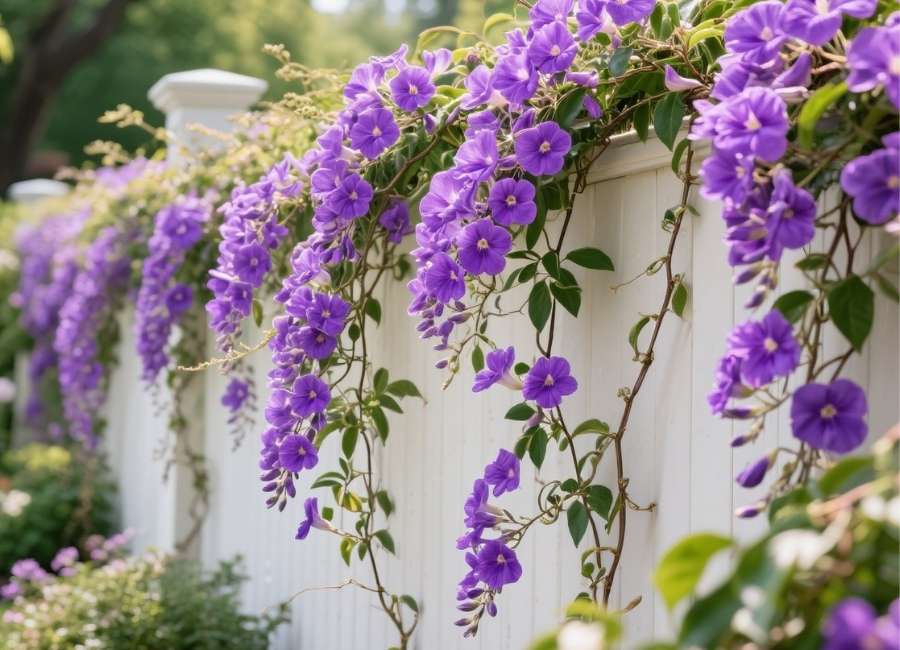Purple flower vines are nature’s artwork. They add a touch of elegance and a pop of vibrant color to your garden, walls, or fences. These vines, known for their striking purple blooms, are not only visually stunning but are also versatile and relatively easy to grow. Whether you’re an experienced gardener or a beginner looking for a high-impact addition to your landscape, purple flower vines can completely elevate your space.
This guide will take you through everything you need to know about purple flower vines, from popular varieties and care tips to creative ways to incorporate them into your garden.
What Makes Purple Flower Vines Special

Purple flower vines are beloved in gardens across the globe for several reasons. Here’s why they stand out:
- Vivid Color: The purple hue is associated with luxury, elegance, and creativity. From deep violet to soft lavender, these vines offer a versatile palette.
- Attracts Pollinators: Bees, butterflies, and hummingbirds can’t resist the nectar from these blooms, making them great for supporting your local ecosystem.
- Versatility: Purple flower vines can grow vertically along trellises or cascade beautifully down walls, adding dimension to your garden.
- Easy Maintenance: Many varieties require minimal care, making them accessible for both novice and seasoned gardeners.
Popular Varieties of Purple Flower Vines
Not all purple flower vines are alike. Here are some popular varieties to consider:

Wisteria (Wisteria sinensis)
Perhaps one of the most well-known purple flower vines, wisteria offers cascading clusters of fragrant purple flowers. Often seen draped over pergolas, it creates a romantic, almost whimsical atmosphere. Best For: Large gardens, pergolas, or trellises.
Care Tips:
- Requires full sun
- Thrives in well-draining soil
- Needs pruning twice a year to prevent overgrowth
Purple Passionflower (Passiflora incarnata)
This exotic-looking vine produces complex and striking purple blooms. Also known as maypop, the passionflower is a hardy, fast-growing vine that can produce edible fruits. Best For: Fences, trellises, and pollinator gardens.
Care Tips:
- Prefers full to partial sun
- Requires well-draining soil
- Needs regular watering
Morning Glory (Ipomoea purpurea)
The classic morning glory vine displays trumpet-shaped purple flowers that bloom early in the day. They are fast-growing and can quickly cover fences or arbors. Best For: Quick coverage of fences, trellises, or unsightly areas.
Care Tips:
- Grows best in full sun
- Water regularly but avoid overwatering
- Can self-seed and spread quickly, so watch for control
Clematis (Clematis ‘Jackmanii’)
This climbing vine produces large and vibrant purple flowers that can last from spring through late summer. It’s a favorite for gardeners seeking long-lasting blooms. Best For: Fences, arbors, or as ground cover.
Care Tips:
- Likes full sun on its blooms and shade on its roots
- Requires well-draining, fertile soil
- Prune according to its specific pruning group
How to Grow Purple Flower Vines

Getting the most out of your purple flower vines starts with proper planting and care. Follow these steps to ensure thriving blooms:
Step 1. Select the Right Location
Purple flower vines thrive in areas with plenty of sunlight (though some varieties tolerate partial shade). Choose a location that offers good air circulation to prevent fungal diseases.
Step 2. Prepare the Soil
While most vines are adaptable, they generally prefer nutrient-rich, well-draining soil. Enrich your soil with compost or manure before planting, and consider testing the pH to ensure it suits your chosen vine species.
Step 3. Provide Structural Support
Purple flower vines are climbers and need a structure for support, such as trellises, arbors, pergolas, or fences. Train your vine onto the structure by gently tying it with garden ties or soft string.
Step 4. Watering and Feeding
Consistency is key when it comes to watering. Most vines need moist (but not waterlogged) soil. Fertilize in early spring with a balanced fertilizer to promote growth and blooms.
Step 5. Prune Regularly
Pruning helps maintain the shape of your vine and encourages new growth. Research the specific pruning needs of your chosen variety since they can vary widely.
Step 6. Watch for Pests and Diseases
Keep an eye out for pests like aphids and spider mites. Treat infestations with insecticidal soap or neem oil. Fungal diseases can often be avoided with proper spacing and airflow.
Creative Ways to Use Purple Flower Vines in Your Garden

Purple flower vines are more than just pretty blooms; they’re versatile elements that can transform your garden’s look and feel. Here’s how to maximize their impact:
Frame Entrances
Use purple flower vines to frame doorways or garden gates. Wisteria or clematis creates a stunning focal point and a warm welcome.
Pergolas and Arbors
Allow vines like wisteria or morning glory to cascade over pergolas or arbors. These structures create shaded areas perfect for outdoor relaxation.
Fence Coverage
Turn an unremarkable fence into a vertical garden with fast growers like morning glory or passionflower. They not only add visual interest but also improve privacy.
Add to Containers
Not all vines need to be grown in the ground. Compact varieties like purple clematis can thrive in containers, making them a great option for decks or patios.
Why Purple Flower Vines Are Perfect for Your Landscape
If you’re looking to elevate your garden, purple flower vines offer a perfect combination of beauty, versatility, and low-maintenance appeal. Their bold blooms can turn even the simplest outdoor spaces into lush, colorful retreats. Plus, their ability to attract pollinators and provide shade makes them as functional as they are stunning.
Whether you’re covering a fence, dressing up an arbor, or simply adding a splash of elegance to your yard, there’s a purple flower vine to fit the bill.











